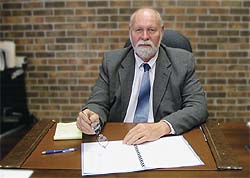 |
 |
(First
in a two-part series on health
care issues in North America) |
|
Santa Rosa, California, Local
551 health and
welfare fund trustees had two choices and both
of them were bad. With health care costs mounting,
they had to convince members to voluntarily
sacrifice an additional $2.05 hourly out of their
checks, about $4,600 a year, or face a cut in benefits,
starting with retiree health care.
A month later,
a special meeting revealed a split in the membership along
generational linesthe younger workers struggling to make
ends meet in a difficult economy versus their older, more
health care-dependent counterparts. In the end, by one vote,
the membership voted to keep their benefits and cope with
a significant hit to their paychecks.
"Its very
ugly and it doesnt seem to be getting any better," said
Steven Benjamin, former Local
551 business manager, who said the bitter feelings over
the premiums caused him to decide against running for a second
term. "If something doesnt change here pretty soon,
our trust is in serious jeopardy. Our wages have been stagnant
for four years. Most of the money is going to the health and
welfare plan because thats where it needs to go."
There is nothing
unique about the predicament faced by Local
551. The same agonizing choices are being made by locals,
multi-employer trust funds and businesses across the country.
Today It Costs Approximately $9,000
a year for a family health care plan in the United states.
in six years, that cost is on track to double. within 12
years, if the present situation continues, a family health
insurance Plan will cost $36,000 a year.
Health Care
Conditions Critical
A looming health
care crisis is the elephant in Americas living room, growing
bigger and more menacing every day. Health care spending in
the United States, already the highest in the world, will
soon double to more than $2.6 trillion, the National Coalition
on Health Care (NCHC) estimates. Gobbling up more and more
of the gross national product, runaway health costs threaten
to drive the United States back into unsustainable deficits,
the General Accounting Office says.
As health insurance
premiums rise at five times the rate of inflation, health
care represents the single biggest issue in labor negotiations
today. Whether its coverage provided by employers or multi-employer
construction benefit funds, no IBEW member remains untouched
by this crisis.
Good benefits,
which have always been a hallmark of union membership, are
threatened by the disintegrating system. Several high-profile
strikes have centered on health care costs, including the
recent five-month action by California grocery workers. Negotiators
in every branch of the IBEW have struggled with the health
care crisis and are bracing for tough talks to come.
"Its no
longer a choice," said IBEW International President Edwin
D. Hill. "The United States failure to address this
catastrophe-in-the-making has only served to feed the beast.
The future of our country depends on whether we find the collective
strength and will to seek a bold national solution to this
problem."
Today, it costs
approximately $9,000 a year for a family health care plan
in the United States. In six years, that cost is on track
to double. Within 12 years, if the present situation continues,
a family health insurance plan will cost $36,000 a year.
Every day, as
the ranks of the uninsured increasecurrently 43 million and
countingthose with coverage pay a larger and larger share
while earning fewer and fewer benefits. The overwhelming majority80
percentof those without coverage comes from working families.
With jobs in
short supply, particularly in places hit hard by a new wave
of global outsourcing, and rising inflation and gasoline prices
making everyday necessities even more expensive, IBEW members
and all workers have been on the losing end of the equation
across the country.
From One Crisis
to Another
About 330,000
of the IBEWs 750,000 active members work in the construction
branch, where health benefits are usually administered by
labor-management health and welfare funds with contributions
from both workers and participating contractors. As partners
in the operation of the multi-employer plans (also called
Taft-Hartley plans), union leaders play an active role in
fund management.

Leland Butler,
plan administrator for Local
995s health and welfare fund, faces tough choices every
day.
"Our experience
has been almost from one crisis to another within the past
three or four years," said Leland Butler, plan administrator
for Local
995 in Baton Rouge, Louisiana. "We put in strict
controls, increased deductibles and out-of-pockets but if
we have a run of real sick people or accidents, then were
dead in the water. It doesnt take much to bust a fund."
The hurdles are
no less severe in other industries where health care is administered
by employers (single employer plans). For example, telecommunications
members employed by AT&T, Verizon and SBC have been forced
to assume a greater share of health care costs while enduring
cutbacks in benefits. Pressure by nonunion competitors has
caused IBEW-represented companies to scale back on spending,
particularly on retiree health care.
Even good pension
plans are not enough to assist retirees whose health care
benefits have been slashed, said Telecommunications Department
Director Martha Pultar.
"If you
are a telephone operator who retired in 1992 and your pension
is $700 a month, you cant afford to be paying $600 monthly
premiums," Pultar said. "Were going to be going
back to the days when seniors are eating cat food to survive.
Thats what weve been up against at the bargaining table
for several years."
Continued Next Page > |
